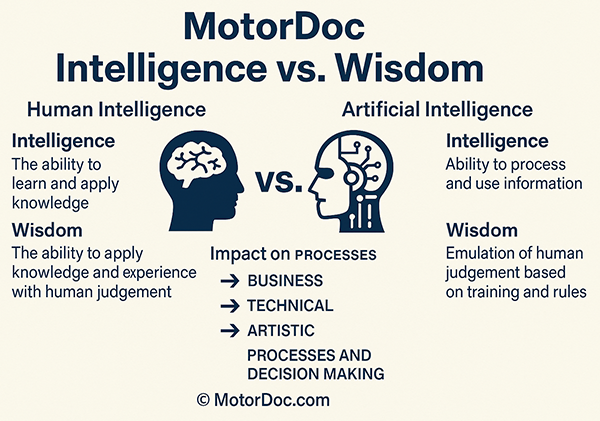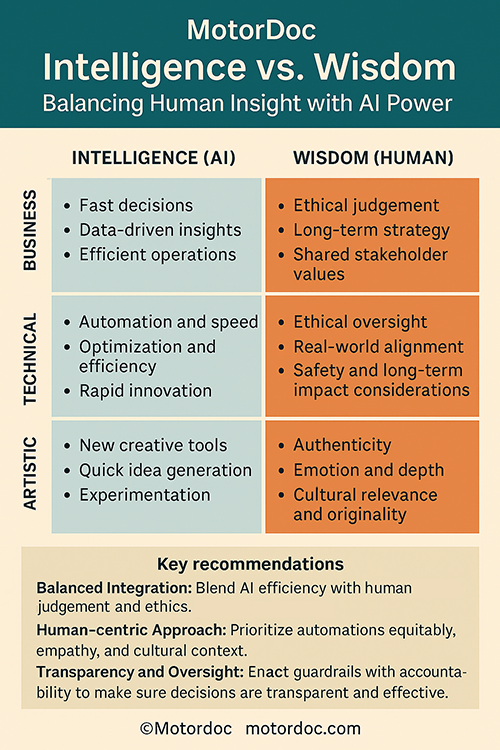This article was co-written with the support of OpenAI’s ChatGPT version 4.5 enterprise edition.
If you read or hear the hype systems deemed Artificial Intelligence (AI) will easily replace human beings for many applications in business, technology and art. We’ve seen the presentations, one given to those who others intend to replace stating that it is to enhance their jobs, and the same groups’ presentations to management explaining how the same technology will replace headcount.
The tech is presented as making better decisions in all things from financial, business strategy, software development, art and marketing, sales and even reliability and maintenance.
AI might be fast and consistent, but it’s not wise—and that matters.
However, as we begin to look at definitions and capabilities, the programmers and developers associated with machine learning and AI techniques continue to provide warnings that are generally unheeded.
This comes from an understanding of what these tools are. While powerful, the descriptions given to the people that companies intend to replace are closer to the truth than the false promises given to senior management.
What Intelligence Is—and What It Isn’t
What is intelligence? It is the capacity to acquire, understand, and apply knowledge and skills. It includes cognitive functions such as problem-solving, reasoning, abstract thinking, pattern recognition, planning, and learning from experience. Where human intelligence is organic and evolved, it is shaped by emotion, context, culture, biological processes, social interaction and experience.
Artificial intelligence is computationally derived and, by definition, it simulates aspects of human cognition by processing data, recognizing patterns, performing logical operation, and learning from feedback.
However, AI lacks in one very important aspect in any decision-making process: wisdom.
Wisdom is the deeper capacity to judge right from wrong, act prudently, integrating experience, knowledge, understanding, empathy, ethics, emotional intelligence, and insight. It involves contextual understanding and applying knowledge ethically and thoughtfully.

In effect, while intelligence is knowing how things work, solving problems, and understanding complex ideas, wisdom is knowing when, why, and if to apply knowledge, considering long-term outcomes, moral implications, and the human context.
Presently, AI does not possess wisdom, but can partially emulate aspects of it by:
- Making recommendations based on large sets of experience (training data).
- Simulating ethical or moral reasoning by adhering to predefined (human-provided) ethical frameworks or rules.
- Incorporating human-influenced value systems such as fairness, safety, or user-defined priorities into decision-making algorithms. In effect, deliberate or accidental bias.
However, AI emulation of wisdom has significant limitations:
- AI currently lacks genuine subjective understanding and real-life experiential context.
- AI lacks emotional insight, empathy, true self-awareness, and an authentic understanding of human values beyond programmed rules.
- AI ‘wisdom’ is confined to the data it has seen or rules it has been provided, meaning it cannot spontaneously adapt ethically and empathetically in truly novel or deeply nuanced situations without human intervention or oversight.
Why Wisdom Still Belongs to Humans
When we consider the implementation of AI and the human context of wisdom, we need to consider the following in the implementation of any machine learning or AI system in a personal or business context:
- Ethical Frameworks: Implementation of AI ‘wisdom’ involves explicitly programming ethical frameworks, oversight, and values-aligned guidance systems to mitigate harmful biases and ethical blind spots.
- Transparency and Explainability: Systems intended to emulate wisdom require transparency and explainability so users can understand how and why particular decisions were reached, fostering trust and accountability. At present, this is something that is tremendously lacking within most AI systems available on the market, with most not able to understand how complex AI systems make their decisions.
- Human-AI Collaboration: AI wisdom is most effective when used in partnership with human oversight, allowing AI’s strengths in speed, data processing, and pattern recognition to complement human judgment using empathy, ethics, and nuanced understanding.
- Continuous Improvement and Alignment: Regularly calibrating and updating AI systems based on feedback from diverse human users helps maintain alignment with evolving societal values and ethics, moving AI closer to meaningful and beneficial emulation of human wisdom.
While AI can emulate aspects of human wisdom superficially, genuine wisdom rooted deeply in empathy, morality, emotional intelligence, and human experience remains fundamentally human.
Effective implementation thus involves carefully guided human-AI interaction, clearly defined ethical frameworks, transparency, continuous improvement, and recognizing the limits of AI in emulating authentic human wisdom.
The differences between intelligence and wisdom, and human and artificial intelligence, profoundly impact business, technical, and artistic processes and decision-making.
At this point, we can explore each of these to provide some insight into the human-AI interaction. There are other areas which are of even greater consideration, such as healthcare, infrastructure, reliability, and safety, which are even more complex.

Overall implications across all of these domains, but definitely not all-inclusive:
- Balanced Integration: Organizations and individuals should strategically blend AI’s computational intelligence with human ethical wisdom and empathy.
- Contextual Awareness: Businesses, technologists, and artists should consciously clarify what AI can and cannot provide ethically or authentically.
- Human-Centric Approach: The most effective implementations integrate AI as an enhancement, not a replacement, for uniquely human qualities such as ethics, emotional understanding, cultural sensitivity, and moral responsibility.
- Human intelligence and wisdom must be included in decision-making and transparency within how the AI system operates for proper oversight.
The future of business, technical, and artistic processes lies not in choosing AI or human wisdom exclusively, but in thoughtfully blending them, thus creating holistic, meaningful, and ethically robust outcomes.
This also extends to such things as reliability and maintenance of AI-based IIoT systems, in which human wisdom amounts to the discernment between conditions and knowing, based on wisdom, the actual conditions and causes.
Outside of anomaly detection, classification of an individual fault using AI can require 100s of thousands or even millions of sets of training data specific to the fault. Human wisdom does not require this same type of training, but it still requires experience and understanding.











